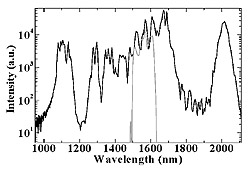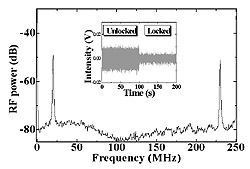Optical Science Laboratory
The carrier-envelope offset (CEO) is an absolute phase slip between
pulses of a mode-locked laser. Recently, progress in the mode-locked laser
techniques has made it possible to generate a CEO-locked frequency comb
from a mode-locked laser pulse and contains various frequency components
in the hundreds of terahertz region which are regularly spaced. The CEO-locked
frequency comb can be used as an "optical frequency ruler" with
a cesium atomic clock for controlling the spacing. Optical frequency measurement
is one of applications of the "ruler". Lasers for applications,
such as precision spectroscopy and telecommunications, should be small
and have a high repetition rate.
However, CEO frequency detection needs an octave bandwidth spectrum
because self-referencing is employed. As a result, a fiber laser needs
amplification, which makes it difficult to reduce the size of the laser
system. Furthermore, telecommunications and precision spectroscopy applications
require a CEO-locked frequency comb with a high repetition rate. The problem
in this case is that the pulse energy becomes smaller as the repetition
rate increases. We therefore need to achieve CEO locking with a small and
high-repetition rate device with low pulse energy.
Our new method employs a tellurite photonic crystal fiber (PCF) for
supercontinuum (SC) generation with low pulse energy, and a periodically
poled lithium niobate (PPLN) ridge waveguide for efficient second harmonic
generation. We found the optimum condition for generating the SC spectrum
by changing the polarization of the laser, the PCF length, and the core
size. We found that a SC spanning more than an octave can be generated
with 80 pJ fiber-coupling pulse energy (Fig. 1). The CEO frequency is measured
with an Mach-Zehnder interferometer by combing the second harmonic into
a PPLN ridge waveguide with the short wavelength components of the SC light.
From the SC shape, we found the optimum wavelength in the 965 nm region
in order to observe the CEO frequency. Hartl et al. succeeded in locking
the CEO with a 600 pJ fiber coupling pulse energy [1]. We have demonstrated
a CEO-locked frequency comb at the telecommunications wavelengths with
a 230 pJ fiber coupling pulse energy, which, to the best of our knowledge,
is the lowest fiber coupling pulse energy ever achieved (Fig. 2) [2]. Due
to the improvement of the coupling efficiency to the PCF, it would be possible
to lock the CEO by using a fiber laser oscillator with a low pulse energy.
[1] I. Hartl, et al., Opt. Express 13 (2005) 6490.
[2] A. Ishizawa, et al., Opt. Express 16 (2008) 4706.
 |
 |
|||||
|
|